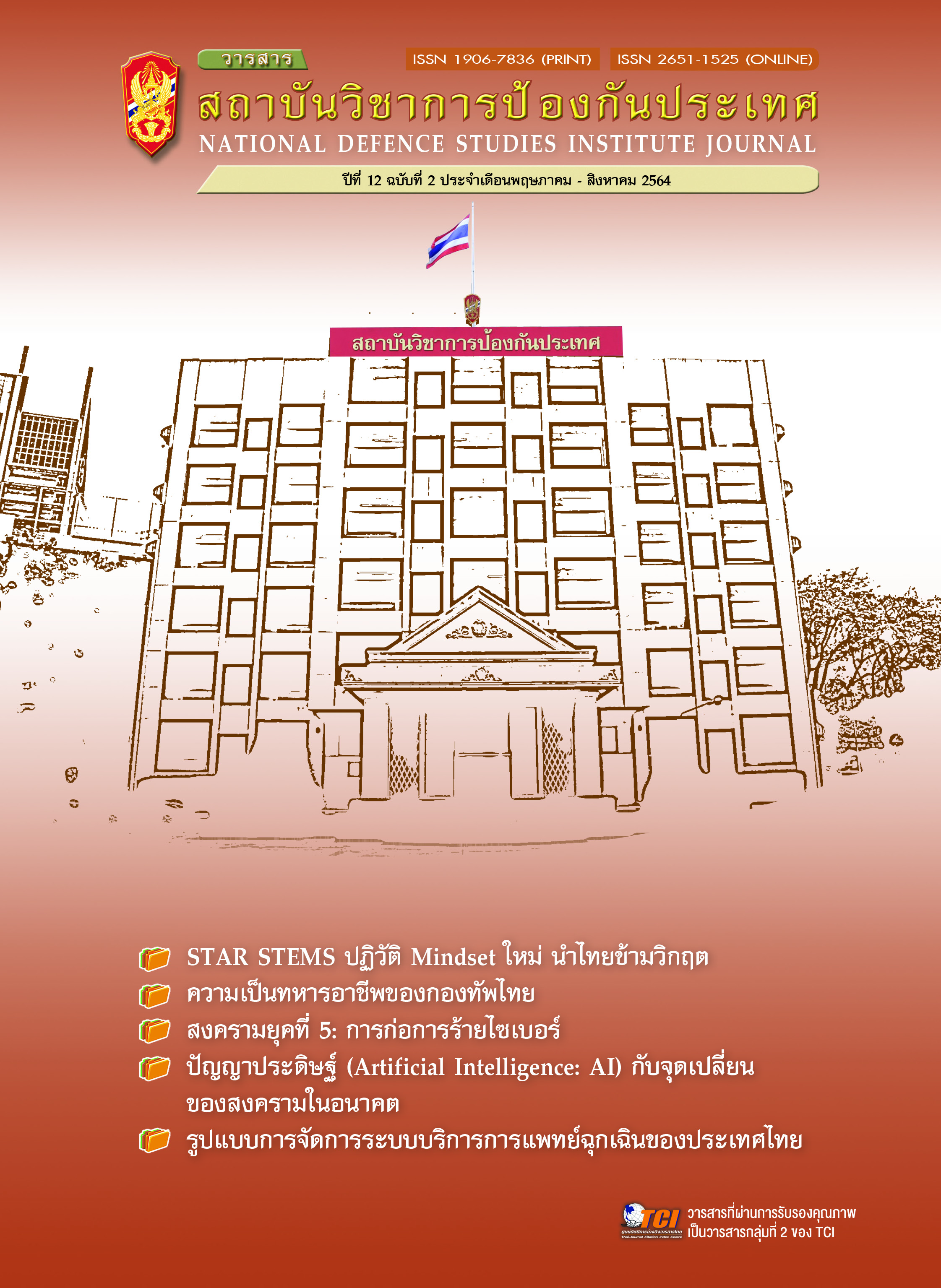The Fifth Dimension of Warfare: Cyber Terrorism
Main Article Content
Abstract
The 5th Dimension of Warfare, Cyberterrorism Cyberwarfare is the key factor in determining strategies for the 5th Dimension of Warfare, which includes threats in two dimensions, namely treats in warfare and threats that are the result of equipment used in warfare. As for the threats of warfare, it has been transformed from conventional warfare to the innovative use of technology as a tool to conduct warfare, in other words, Cyber Warfare. As for the strategic tools that have been used to counter non-conventional threats or non-conventional warfare, it is a necessity for security organizations to adapt their strategies, capabilities among personnel as well as tactics due to the transformation of the battlefield towards Hybrid Warfare. This new type of warfare incorporates Conventional Warfare with Irregular Warfare. The main difference between Conventional Warfare and Cyberwarfare is that the aims of operations in the 5th Dimension of Warfare do not target the loss of lives as a result, but carry out the operation through disruptive tactics, which are so-called System-disruption Operations. The advantage of the operation depends on the development and utilization of programs, as well as the various dimensions of the means of attacking through hackers. These individuals/groups will carry out guerilla warfare that targets military assets, Command and Control, Internet of Battlefield Things: IoBT, Critical Infrastructure, and vulnerable targets.
It can be summarized that the success of Hybrid Warfare depends on the concentration of force, integrating operational and tactical plans (conventional warfare, terrorism, and technology) and joint attacks at the enemy’s center of gravity, which disrupts the operation of key infrastructures.
Article Details

This work is licensed under a Creative Commons Attribution-NonCommercial-NoDerivatives 4.0 International License.
The articles, images, tables, graphs, written content, and opinions published in this journal are solely those of the authors and do not necessarily reflect the views or positions of the National Defence Studies Institute or its academic affiliates.
References
“พระราชบัญญัติการรักษาความมั่นคงปลอดภัยไซเบอร์ พ.ศ.2562” (2562, 27 พฤษภาคม). ราชกิจจานุเบกษา. เล่ม 136 ตอนที่ 69 ก.
“พระราชบัญญัติข่าวกรองแห่งชาติ พ.ศ.2562” (2562, 16 เมษายน). ราชกิจจานุเบกษา. เล่ม 136 ตอนที่ 50 ก.
สุรชาติ บำรุงสุข. (2016). การก่อการร้ายในเมือง: Urban Terrorism. กรุงเทพฯ: Square Print.
_______. (2017). สงครามอสมมาตร แบบแผนความขัดแย้งใหม่: Asymmetric Warfare. กรุงเทพฯ: Square Print.
_______. (2019). โฉมหน้าใหม่ของสงคราม : The New Face of War. กรุงเทพฯ: Square Print.
Borghard, E. (2020). Operationalizing Defend Forward: How the Concept Works to Change Adversary Behavior. Retrieved March 20, 2021 from https://www.lawfareblog.com/operationalizing-defendforward- how-concept-works-change-adversary-beharior
Cohen, J. & Schmidt, E. (2014). The New Digital Age. London: John Murray
Danahar, P. (2015). The New Middle East: The World After the Arab Spring. New York: Bloomsbury.
Fishcherkeller, M. & Harknett, R. (2017). Deterrence is Not a Credible Strategy for Cyberspace.Retrieved March 15, 2019 from doi:10.1016/j.orbis.2017.05.003
Fridman, O. (2018). Russian Hybrid Warfare. London: C. Hurst & Co
Hoffman, B. (2017). Inside Terrorism. New York: Columbia University Press
Martin, S. & Weinberg, L. (2017). The Role of Terrorism in Twenty-First-Century Warfare. Manchester University Press
Mazanec, B. & Whyte, C. (2019). Understanding Cyber Warfare: Politics. New York : Policy and Strategy,Routledge
Mearsheimer, J. J. (2014). The Tragedy of Great Power Politics. New York : W.W. Norton & Co.
Mockkaitis, T. R. (2008). The “New” Terrorism: Myths and Relaity. California : Stanford University Press.
Mousavian, S. H. & Shaahidsaless, S. (2014). Iran and the United States. New York : Bloomsbury.


